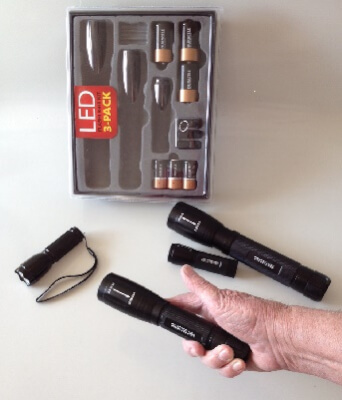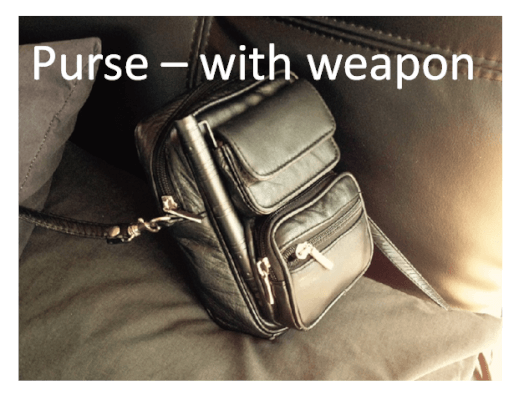Best Survival Flashlights
Essential for Each Emergency Kit
When your house suddenly goes black because of a power outage, or you find yourself marooned in a rain storm, or you’re simply late getting out of a meeting and have a large dimly-lighted parking lot to cross in order to get to your car . . . you want the best flashlight possible! The picture below shows some of the best survival flashlights in our collection.

As always, the best flashlight depends on what you need at the time.
- Do you need a very bright narrow beam to be able to repair broken machinery?
- Do you need a wide, broad beam to show all the places where someone could ve hiding?
- Do you want your flashlight to be so lightweight that you carry it all the time?
- Do you consider your flashlight as a potential weapon?
- Do you need a flashlight whose batteries are easy to change, even when you’re wearing gloves?
Let’s look at the features you’ll want to consider.
Assume you will be looking at an LED (light-emitting diode) flashlight. LED flashlights last longer, weigh less, don’t get hot, and are smaller and sturdier than the incandescent lights we grew up with. Above all, they are brighter. So look for the LED description!
Brightness
Light output is measured in lumens. It can vary from as low as 19 lumens, for a simple all-purpose light to wear around your neck on a lanyard, to as high as 1,000 or even 3,000 lumens for so-called “tactical” flashlights. (So bright they blind the opponent.) In our experience, the minimum you want for your survival kit is 200 lumens, and you may prefer 500 or more.
As you can imagine, the more power the more the flashlight costs – BUT IT’S NOT THE CASE OF A SIMPLE PROGRESSION. Be sure to comparison shop!
Beam
The reflector around the bulb determines whether all the light is focused in one narrow beam, or whether it spreads out more like a flood light. What you need the light for determines what shape beam you like.
Many LED flashlights allow you to adjust the beam by zooming in or out. Keep reading.
Battery
Batteries help determine the weight of the flashlight, its cost, and its overall convenience. Having to replace batteries frequently can be a nuisance as well as expensive, but you can easily keep extras at hand. Most flashlights still use AA, AAA, C or even D cell disposable batteries. (A big flashlight with D batteries can be a formidable personal defense weapon.)
Rechargeable batteries last longer and are more convenient as long as you have recharge capability (from your computer, an electrical outlet or a solar panel, or a hand crank). These batteries do cost more.
For your survival kit, the best power source is likely to be a rechargeable battery. For your shelter-in-place stash, which may have to carry you for quite a while, consider traditional batteries and/or crank or solar power.
Mode
The best flashlights are no longer simply on or off. As mentioned above, they may be zoomed in or out for less or more light. They may have a low beam and a high beam, both of which may be zoomed. They may have two or more modes: a solid white beam, a blinking white beam (strobe) for signaling, a blinking red beam, or even a blink pattern that sends out an SOS in Morse code.
More modes typically mean more switches and circuitry and thus more expense.
Extras
Other features you may look for include . . .
- A design with one flat side so the flashlight doesn’t roll when it’s set down on a flat surface
- Extra heavy duty or water resistant case depending on how you’ll use the flashlight
- Wrist-strap or specially designed grip
Our recommendations
We own many flashlights, and seem to keep trying new ones.
- We like to give small, inexpensive flashlights as gifts or as rewards (“Use this to start your emergency kit!”).
- I have a couple of compact, light-weight flashlights that fit in my briefcase and purse.
- In our cars we carry large, heavy-weight flashlights that could be used to break a window as well as find a disconnected fuse or wire in the engine compartment.
- Every room in our house has a simple 200 lumen or more light tucked in a handy, secure place. (Remember, we’re in earthquake country!)
- And finally, our recommendations for the BEST flashlights for your survival kit —
We always have flashlights, and because styles change (and companies go in and out of business!) our favorite changes, too. Here are two to consider for 2023.
Click on the images to get current prices at Amazon.
(As an Amazon Affiliate, I will receive a small commission if you click on one of our links and make a purchase. There is no extra charge to you.)
GearLight LED Flashlight for everyday use

- I like the size of this flashlight, and how it fits easily into my hand or pocket.
- I also feel very comfortable carrying the light in the dark, knowing that the design of the rim, with cutouts and sharp surfaces, turns it into somewhat of a weapon.
- This model also has flat surfaces to keep the light from rolling when it’s placed on a flat surface.
This light is plenty bright. And today, when I checked, it is on sale!
In any case, it claims to be “Military grade” – and water resistant. It has 5 lighting modes. Great for everyday use. Again, click on the image to get the latest price and packaging.
Take a look at some of the other small flashlights, too. As always, by shopping you may get a better deal.
Option for heavy-duty security flashlight

This classic flashlight from Everbright uses C batteries — so it is larger and heavier than the everyday model above. We like the 3 different lighting modes (high, low and strobe) and the fact that the beam can reach clear out to 1000 feet on high-beam mode! We have similar lights in our cars, for emergencies and as potential weapons. Check costs and get all details for this Everbright by clicking on the image.
Check out all these recommendations and compare carefully before you buy. But get the flashlights you need – several for the house (We have one in every room.), one for each car and one for each emergency kit.
Flashlights are essential emergency gear!
Virginia
Your Emergency Plan Guide Team











